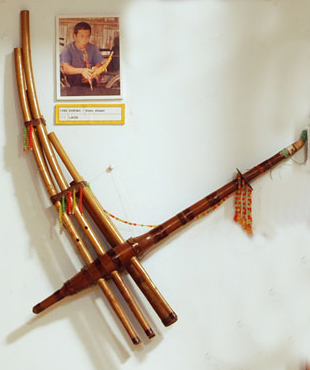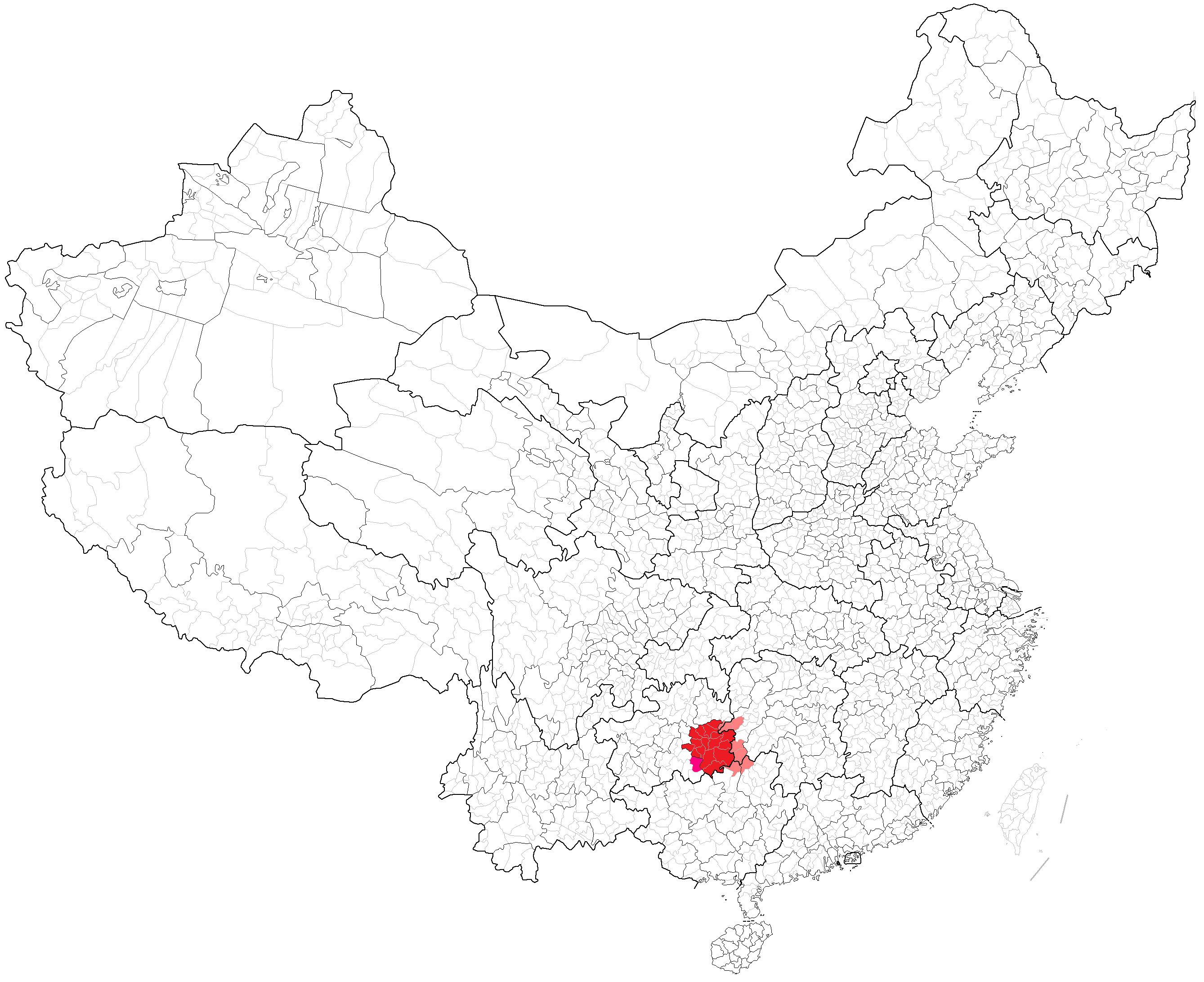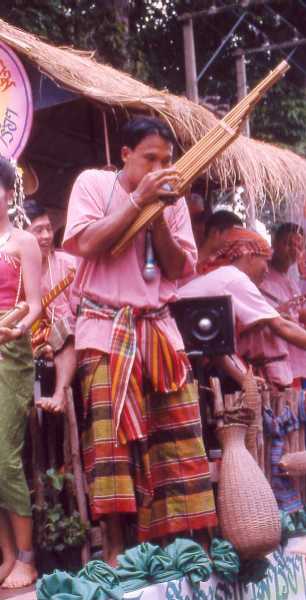|
Lusheng
The ''lusheng'' (, ; Vietnamese: ''Khèn Mông''; also spelled ''lu sheng''; spelled ''ghengx'' in standard Hmong and ''qeej'' in Laotian RPA Hmong) is a Hmong musical instrument. It has a long history of 3000 years in China, traced back to the Tang Dynasty. It is a mouth organ with multiple bamboo pipes, each fitted with a free reed, which are fitted into a long blowing tube made of hardwood. It most often has five or six pipes of different pitches and is thus a polyphonic instrument. Its construction includes six parts ( mouthpiece, air feed pipe, ''sheng dou'' (笙斗, body), ''sheng guan'' (笙管, pipes), reed, and resonator tube). It comes in sizes ranging from very small to several meters in length. The ''lusheng'' is used primarily in the rural regions of southwestern China (e.g. Guizhou, Guangxi, and Yunnan) and in nearby countries such as Laos and Vietnam, where it is played by such ethnic groups as the Miao (Hmong-Hmyo-Hmao-Hmu-Xong) and Dong. The ''lusheng'' has sp ... [...More Info...] [...Related Items...] OR: [Wikipedia] [Google] [Baidu] |
Mouth Organ
A mouth organ is any free reed aerophone with one or more air chambers fitted with a free reed. Though it spans many traditions, it is played universally the same way by the musician placing their lips over a chamber or holes in the instrument, and blowing or sucking air to create a sound. Many of the chambers can be played together or each individually. The mouth organ can be found all around the world and is known by many different names and seen in many different traditions. The most notable variations include the harmonica, and Asian free reed wind instruments consisting of a number of bamboo pipes of varying lengths fixed into a wind chest; these include the ''sheng'', ''khaen'', ''lusheng'', ''yu'', ''shō'', and '' saenghwang''. The melodica, consisting of a single tube that is essentially blown through a keyboard, is another variation. Gallery File:Cass-muha-1880.jpg, C. A. Seydel Söhne Harmonica (1880) File:Mouth organ (or symphonium) (c.1830, London) by Charles Wh ... [...More Info...] [...Related Items...] OR: [Wikipedia] [Google] [Baidu] |
Hulusheng
The gourd mouth organ is a free reed mouth organ played across East and Southeast Asia. It consists of a gourd wind chest with several bamboo or bronze pipes inserted on top of it, the numbers of pipes differing from region to region.Sachs, C. (2012). The history of musical instruments. Courier Corporation. The gourd mouth organ is closely associated with cultural minorities in Asian countries; thus, its styles are diverse, and different counterparts can be seen across different cultures.Uchida, R., & Catlin, A. (2008). Music of upland minorities in Burma, Laos, and Thailand. The Garland Handbook of Southeast Asian Music, 303-316. In southern China, the generic name of the gourd mouth organ is ''Hulu Sheng'' Thrasher, A. R. (2015). Hulu sheng. In New Grove Dictionary of Music and Musicians. Oxford University Press. Retrieved from https://doi.org/10.1093/gmo/9781561592630.article.L2281219 ( 葫芦 笙; pinyin: húlúshēng; literally "gourd sheng"). The accompaniment of the ... [...More Info...] [...Related Items...] OR: [Wikipedia] [Google] [Baidu] |
Dong People
The Kam people, officially known in China as Dong people (; endonym: , ), a Kam–Sui people of Southern China, are one of the 56 ethnic groups officially recognized by the People's Republic of China. They are famed for their native-bred ''Kam Sweet Rice'' (), carpentry skills and unique architecture, in particular a form of covered bridge known as the "wind and rain bridge" (). The Kam people live mostly in Eastern Guizhou, Western Hunan and Northern Guangxi in China. Small pockets of Kam speakers are found in Tuyên Quang Province in Vietnam. The Kam people call themselves Kam, Geml, Jeml or Gaelm. History The Kam are thought to be the modern-day descendants of the ancient Liáo (僚) peoples who occupied much of southern China.D. Norman Geary, Ruth B. Geary, Ou Chaoquan, Long Yaohong, Jiang Daren, Wang Jiying (2003). ''The Kam People of China: Turning Nineteen''. (London / New York, RoutledgeCurzon 2003). . Kam legends generally maintain that the ancestors of the Kam migrate ... [...More Info...] [...Related Items...] OR: [Wikipedia] [Google] [Baidu] |
Mangtong
The ''mangtong'' () is a Chinese end-blown free reed wind instrument. It is used primarily by the Miao and Dong ethnic groups of the southern Chinese provinces of Guizhou and Guangxi, although it is sometimes used in contemporary Chinese compositions for the traditional instrument orchestra. The instrument consists of a bamboo-free reed pipe without finger holes, which is fitted with a metal free reed; the instrument's playing pipe is placed inside a bamboo resonator of larger diameter. The ''mangtong'' is made in several different sizes, with the largest up to two meters in length. As the ''mangtong'' produces only a single pitch, several ''mangtong'' are normally played together in hocket. ''Mangtong'' are often played together with an ensemble of free reed mouth organs called ''lusheng'', serving as the bass instruments of that ensemble. A modernized version of the ''mangtong'', called ''gǎigé mángtǒng'' (), was developed in the 20th centur See also *Lusheng *Yu (wind ... [...More Info...] [...Related Items...] OR: [Wikipedia] [Google] [Baidu] |
Khene
The ''khene'' (; spelled "Can" in English; Lao: ແຄນ; th, แคน, , ; km, គែន - ''Ken''; Vietnamese: ''khèn'') is a Lao mouth organ whose pipes, which are usually made of bamboo, are connected with a small, hollowed-out hardwood reservoir into which air is blown. The khene is the national instrument of Laos. The khene music is an integral part of Lao life that promotes family and social cohesion and it was inscribed in 2017 on the UNESCO Representative List of the Intangible Cultural Heritage of Humanity''.'' Although it is associated with the Lao people of Laos and Isan (Northeast Thailand) nowadays, other similar instruments date back to the Bronze Age. In Cambodia, it is used among the ethnic Lao population of the province of Stung Treng and is used in ''lakhon ken'', a Cambodian dance drama genre that features the ''khene'' as the main instrument In Vietnam, this instrument is used among the Tai peoples and the Muong people. The khene uses a free reed ma ... [...More Info...] [...Related Items...] OR: [Wikipedia] [Google] [Baidu] |
Sheng (instrument)
The ( zh, c=笙) is a Chinese mouth-blown polyphonic free reed instrument consisting of vertical pipes. It is one of the oldest Chinese instruments, with images depicting its kind dating back to 1100 BCE, and there are original instruments from the Han dynasty that are preserved in museums today. Traditionally, the has been used as an accompaniment instrument for solo or performances. It is one of the main instruments in and some other forms of Chinese opera. Traditional small ensembles also make use of the , such as the wind and percussion ensembles in northern China. In the modern large Chinese orchestra, it is used for both melody and accompaniment. The has been used in the works of a few non-Chinese composers, including Unsuk Chin, Jukka Tiensuu, Lou Harrison, Tim Risher, Daníel Bjarnason, Guus Janssen and Christopher Adler. Some believe that Johann Wilde and Pere Amiot traveled to China and brought the first to Europe in 1740 and 1777 respectively, although th ... [...More Info...] [...Related Items...] OR: [Wikipedia] [Google] [Baidu] |
Yu (wind Instrument)
The ''Yu'' (; pinyin: yú) is a free reed wind instrument used in ancient China. It is similar to the sheng, with multiple bamboo pipes fixed in a wind chest which may be made out of bamboo, wood, or a gourd. Each pipe contains a free reed, which is also made of bamboo. Whereas the sheng is used to provide simultaneous tones in harmony (in fourths and fifths), the ''yu'' is played in single lines melodically. The instrument was used, often in large numbers, in court orchestras of ancient China (and was also exported to Korea and Japan) but is no longer used. History Although the ''yu'' is now obsolete, it is known to most Chinese speakers through the saying "Làn yú chōng shù" (), meaning "to fill a position without having the necessary qualifications." The saying is derived from the story of Nanguo (), a man who joined the royal court orchestra of King Xuan of Qi (, 319 BC–300 BC), the ruler of the State of Qi (Shandong province) as a ''yu'' player. Although the man ... [...More Info...] [...Related Items...] OR: [Wikipedia] [Google] [Baidu] |
Miao Musicians
Miao may refer to: * Miao people, linguistically and culturally related group of people, recognized as such by the government of the People's Republic of China * Miao script or Pollard script, writing system used for Miao languages * Miao (Unicode block), a block of Unicode characters of the Pollard script * '' Miào'' (庙), a Chinese temple * Miáo (surname), a Chinese surname written 苗 * Miào (surname), a Chinese surname written 繆 * Miao, Chongming County (庙镇), town in Chongming District, Shanghai, China * Miao, Changlang, town in Arunachal Pradesh, India * Roman Catholic Diocese of Miao, in India * ''Miao'' (album), album by Candy Lo * "Mr. Miao", a short story by Pu Songling See also *Miao Rebellion (other) * Miao Miao * Meow (other) Meow is an imitative word for a sound made in cat communication. Meow or Miaow may also refer to: Film and television * ''Meow'' (2017 film), a 2017 Hong Kong science fantasy comedy film * ''Meow'' (2021 film), ... [...More Info...] [...Related Items...] OR: [Wikipedia] [Google] [Baidu] |
Soprano
A soprano () is a type of classical female singing voice and has the highest vocal range of all voice types. The soprano's vocal range (using scientific pitch notation) is from approximately middle C (C4) = 261 Hz to "high A" (A5) = 880 Hz in choral music, or to "soprano C" (C6, two octaves above middle C) = 1046 Hz or higher in operatic music. In four-part chorale style harmony, the soprano takes the highest part, which often encompasses the melody. The soprano voice type is generally divided into the coloratura, soubrette, lyric, spinto, and dramatic soprano. Etymology The word "soprano" comes from the Italian word '' sopra'' (above, over, on top of),"Soprano" '' |
Alto
The musical term alto, meaning "high" in Italian (Latin: ''altus''), historically refers to the contrapuntal part higher than the tenor and its associated vocal range. In 4-part voice leading alto is the second-highest part, sung in choruses by either low women's or high men's voices. In vocal classification these are usually called contralto and male alto or countertenor. Such confusion of "high" and "low" persists in instrumental terminology. Alto flute and alto trombone are respectively lower and higher than the standard instruments of the family (the standard instrument of the trombone family being the tenor trombone), though both play in ranges within the alto clef. Alto recorder, however, is an octave higher, and is defined by its relationship to tenor and soprano recorders; alto clarinet is a fifth lower than B-flat clarinet, already an 'alto' instrument. There is even a contra-alto clarinet, (an octave lower than the alto clarinet), with a range B♭0 – D4. Etymo ... [...More Info...] [...Related Items...] OR: [Wikipedia] [Google] [Baidu] |
Ancestor
An ancestor, also known as a forefather, fore-elder or a forebear, is a parent or (recursively) the parent of an antecedent (i.e., a grandparent, great-grandparent, great-great-grandparent and so forth). ''Ancestor'' is "any person from whom one is descended. In law, the person from whom an estate has been inherited." Two individuals have a genetic relationship if one is the ancestor of the other or if they share a common ancestor. In evolutionary theory, species which share an evolutionary ancestor are said to be of common descent. However, this concept of ancestry does not apply to some bacteria and other organisms capable of horizontal gene transfer. Some research suggests that the average person has twice as many female ancestors as male ancestors. This might have been due to the past prevalence of polygynous relations and female hypergamy. Assuming that all of an individual's ancestors are otherwise unrelated to each other, that individual has 2''n'' ancestors in the ' ... [...More Info...] [...Related Items...] OR: [Wikipedia] [Google] [Baidu] |
Religion
Religion is usually defined as a social- cultural system of designated behaviors and practices, morals, beliefs, worldviews, texts, sanctified places, prophecies, ethics, or organizations, that generally relates humanity to supernatural, transcendental, and spiritual elements; however, there is no scholarly consensus over what precisely constitutes a religion. Different religions may or may not contain various elements ranging from the divine, sacred things, faith,Tillich, P. (1957) ''Dynamics of faith''. Harper Perennial; (p. 1). a supernatural being or supernatural beings or "some sort of ultimacy and transcendence that will provide norms and power for the rest of life". Religious practices may include rituals, sermons, commemoration or veneration (of deities or saints), sacrifices, festivals, feasts, trances, initiations, funerary services, matrimonial services, meditation, prayer, music, art, dance, public service, or other aspects of human cultur ... [...More Info...] [...Related Items...] OR: [Wikipedia] [Google] [Baidu] |






